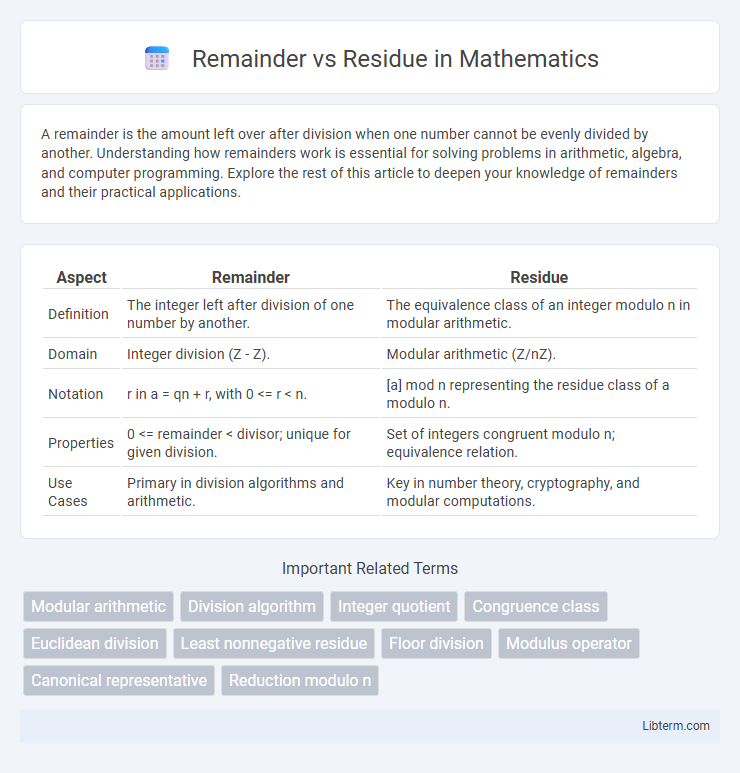A remainder is the amount left over after division when one number cannot be evenly divided by another. Understanding how remainders work is essential for solving problems in arithmetic, algebra, and computer programming. Explore the rest of this article to deepen your knowledge of remainders and their practical applications.
Table of Comparison
| Aspect | Remainder | Residue |
|---|---|---|
| Definition | The integer left after division of one number by another. | The equivalence class of an integer modulo n in modular arithmetic. |
| Domain | Integer division (Z - Z). | Modular arithmetic (Z/nZ). |
| Notation | r in a = qn + r, with 0 <= r < n. | [a] mod n representing the residue class of a modulo n. |
| Properties | 0 <= remainder < divisor; unique for given division. | Set of integers congruent modulo n; equivalence relation. |
| Use Cases | Primary in division algorithms and arithmetic. | Key in number theory, cryptography, and modular computations. |
Understanding Remainder and Residue: Key Definitions
Remainder refers to the integer left over after division when one number does not divide another evenly, often used in modular arithmetic and number theory. Residue denotes the equivalence class of integers that share the same remainder modulo a given number, playing a crucial role in residue classes and modular systems. Understanding these definitions is essential for computations in modular arithmetic, cryptography, and abstract algebra.
Historical Origins of Remainder and Residue
The historical origins of the remainder trace back to ancient arithmetic practices where division problems required notation for what was left after extracting full quotient multiples, foundational in Euclidean algorithm and number theory. Residue, on the other hand, emerged more prominently in modular arithmetic with roots in Gauss' work on congruences, emphasizing equivalence classes rather than just leftover quantities. This distinction highlights remainder as a concrete leftover quantity and residue as an abstract equivalence class in modular systems.
Mathematical Contexts: Where Remainder and Residue Appear
In mathematical contexts, the remainder appears primarily in division algorithms where it represents the integer left over after dividing one integer by another. Residue arises in modular arithmetic and number theory, denoting the equivalence class of integers congruent modulo a given modulus. While the remainder is a specific numeric value between 0 and the divisor minus one, residue refers to the broader concept of classes that define modular relationships among integers.
Remainder in Division: The Basics
Remainder in division refers to the amount left over after dividing one integer by another when the division is not exact. It is the non-negative integer less than the divisor that represents what remains after subtracting the largest multiple of the divisor from the dividend. Understanding remainders is essential in modular arithmetic, computer algorithms, and number theory, where precise calculations of division outcomes are critical.
Residue in Modular Arithmetic: An Overview
Residue in modular arithmetic represents the remainder when an integer is divided by a modulus, forming equivalence classes known as residue classes. These residues are fundamental in number theory, cryptography, and computer science for solving congruences and performing calculations within a finite system. Understanding residues enables efficient computation of modular inverses, discrete logarithms, and plays a crucial role in algorithms like RSA encryption and hash functions.
Common Confusions: Remainder vs Residue
Remainder and residue are often confused but have distinct meanings in mathematics; the remainder is the integer left over after division, while residue refers to the equivalence class of a number modulo another number in modular arithmetic. The remainder is always non-negative and less than the divisor, but residues can be negative or positive depending on the modular system used. Understanding this difference is crucial for correctly solving problems in number theory, cryptography, and computer science.
Practical Applications of Remainder
Remainders play a crucial role in computer science, particularly in algorithms involving modular arithmetic, such as cryptography and hashing functions. They enable efficient data distribution and error detection by handling divisions where only the leftover part of a quotient matters. Practical applications include calculating cyclic patterns, implementing pseudorandom number generators, and optimizing memory addressing in database and cache designs.
Real-World Uses of Residue
Residue in mathematics refers to the amount left after division involving real or complex functions, widely used in complex analysis for evaluating integrals and solving differential equations. In real-world applications, residue assists in signal processing for filtering and system analysis, as well as in engineering for stability analysis of control systems. The concept also plays a critical role in chemistry for quantifying leftover substances after reactions and in residue calculus applied to physics problems involving wave functions.
Remainder and Residue in Advanced Mathematics
In advanced mathematics, the remainder refers to the amount left over after division when one polynomial or integer is divided by another, encapsulating exact modular relationships in Euclidean algorithms. The residue, often used in complex analysis and number theory, denotes the coefficient of the \((z - z_0)^{-1}\) term in the Laurent series expansion of a function around a singularity \(z_0\), critical for calculating complex integrals via the residue theorem. Emphasizing modular arithmetic, the remainder is an integer within a specific range, while residues extend to abstract algebraic structures and complex functions, highlighting their distinct but interconnected roles in higher-level mathematical analysis.
Summary Table: Remainder vs Residue at a Glance
The summary table comparing remainder vs residue highlights that a remainder is the integer left after division when one integer is divided by another, always non-negative and less than the divisor. Residue represents the equivalence class of integers modulo a number in modular arithmetic, encompassing all numbers congruent to each other under modulo operation. While remainders focus on division outcomes, residues are central to number theory, describing cyclical patterns within modular systems.
Remainder Infographic

 libterm.com
libterm.com